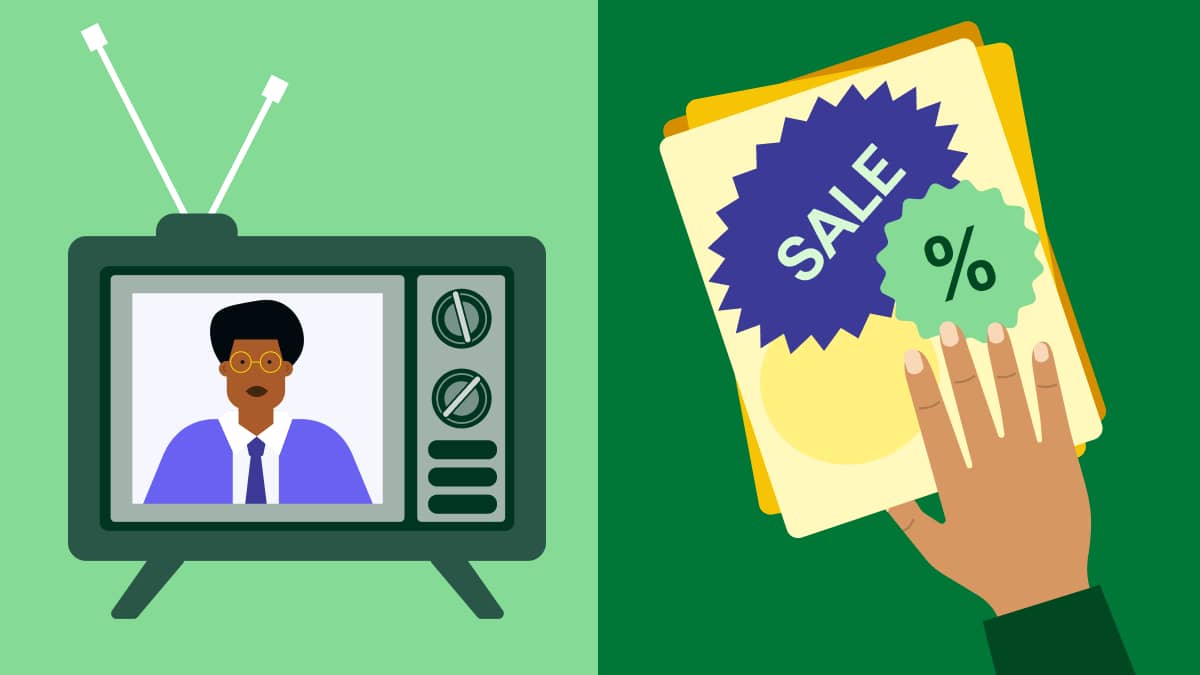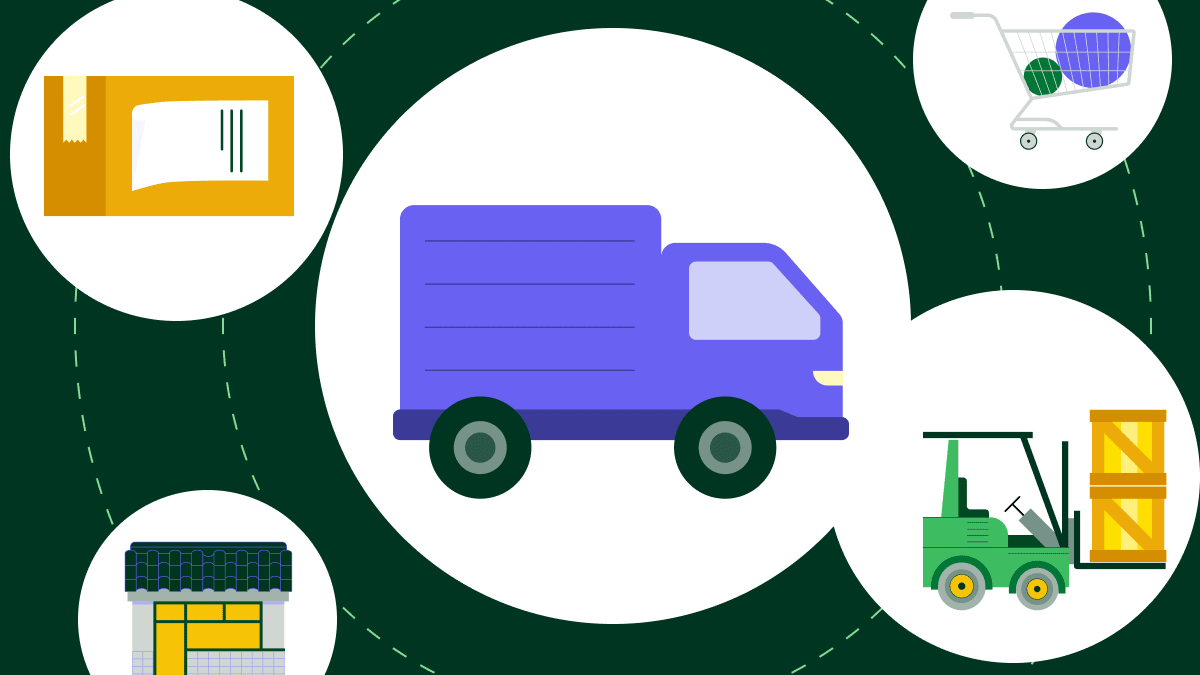Digital marketing might feel like the smart, cost-effective choice. But how do you stand out when every small business uses the same online tactics?
One of the main reasons traditional marketing methods are still so powerful is that so many companies overlook them in favor of newer tools, giving users a competitive advantage.
In this guide, you’ll learn which offline techniques still grab attention, how they support digital efforts and how to ensure you and your stakeholders see real sales results fast.
What is traditional marketing (and how does it differ from digital)?
Traditional marketing is any form of offline communication that aims to promote a business, brand or product. It includes classic methods that have persuaded buyers for decades, like:
TV ads
Billboards
Direct mail
Radio spots
Flyers
Cold calling
Promotional events
All these tactics push messages out to broad groups, most without expecting immediate feedback.
Many businesses still use traditional marketing channels because they’re familiar and tangible. Add some creativity and they can be memorable, too.
Take the Intuit TV commercial below. The software brand uses a relatable pain point (falling behind on admin), surreal imagery (computer-generated chickens) and a snappy tagline (“Get peace of mind. Get QuickBooks”) to stick in small business owners’ minds.
This traditional ad complements Intuit’s digital efforts. It’s part of a broader marketing strategy alongside social media, search engine optimization (SEO) and blog content.
Traditional vs. digital marketing: the key differences
While it’s unhelpful to treat traditional and digital marketing as competitors, knowing their key differences can help you understand how they complement one another so perfectly.
Here’s a speedy comparison based on cost, targeting, speed and measurement:
Aspect | Traditional marketing | Digital marketing |
Cost | While usually more expensive upfront, it offers better value when scaled. | Cheaper to start with, followed by cost spikes in competitive markets. |
Targeting | Works well for geographic or age-based targeting, though less precise overall. | Highly specific targeting, depending on platform rules and data access. |
Speed | Slower to plan and produce, then runs with minimal input once live. | Quicker to launch, but often needs constant tweaking and updates. |
Measurement | Tracks brand recall and responses, although data usually comes in after the fact. | Shows real-time performance through clicks, opens and other live marketing metrics. |
So, while digital offers fast turnaround and precise targeting, traditional channels of marketing bring something different. The customer’s brand experience is often more memorable, and that kind of impact still matters in a crowded digital space.
When inboxes are full and social media timelines scroll endlessly, a well-designed brochure or a radio spot with personality can cut through. These and other traditional marketing examples give people a reason to pause and your brand space to stand out in today’s digital age.
Why traditional marketing tactics still matter in 2025
Offline marketing methods continue delivering strong results for clever, strategically-minded businesses. Rather than disappearing like many predicted, they’ve evolved to work alongside digital media and create more comprehensive marketing plans.
Here are the biggest reasons to invest in your traditional marketing strategy.
It provides a different kind of reach and trust
Traditional marketing techniques are familiar, visible and more trustworthy for some target audiences.
For example, a radio ad or flyer doesn’t rely on algorithms to be visible, and a printed handout can’t get buried in inbox spam.
These tangible formats carry weight, especially with customer demographics who value clear, direct communication. For example, Media Logic reports that over half of adults aged 65 to 73 read print newspapers or a combination of print and digital, and 83% listen to AM/FM radio.
This circumstantial effectiveness explains why over a third of small business leaders plan to keep traditional marketing spending steady, and 45.8% will budget for more.
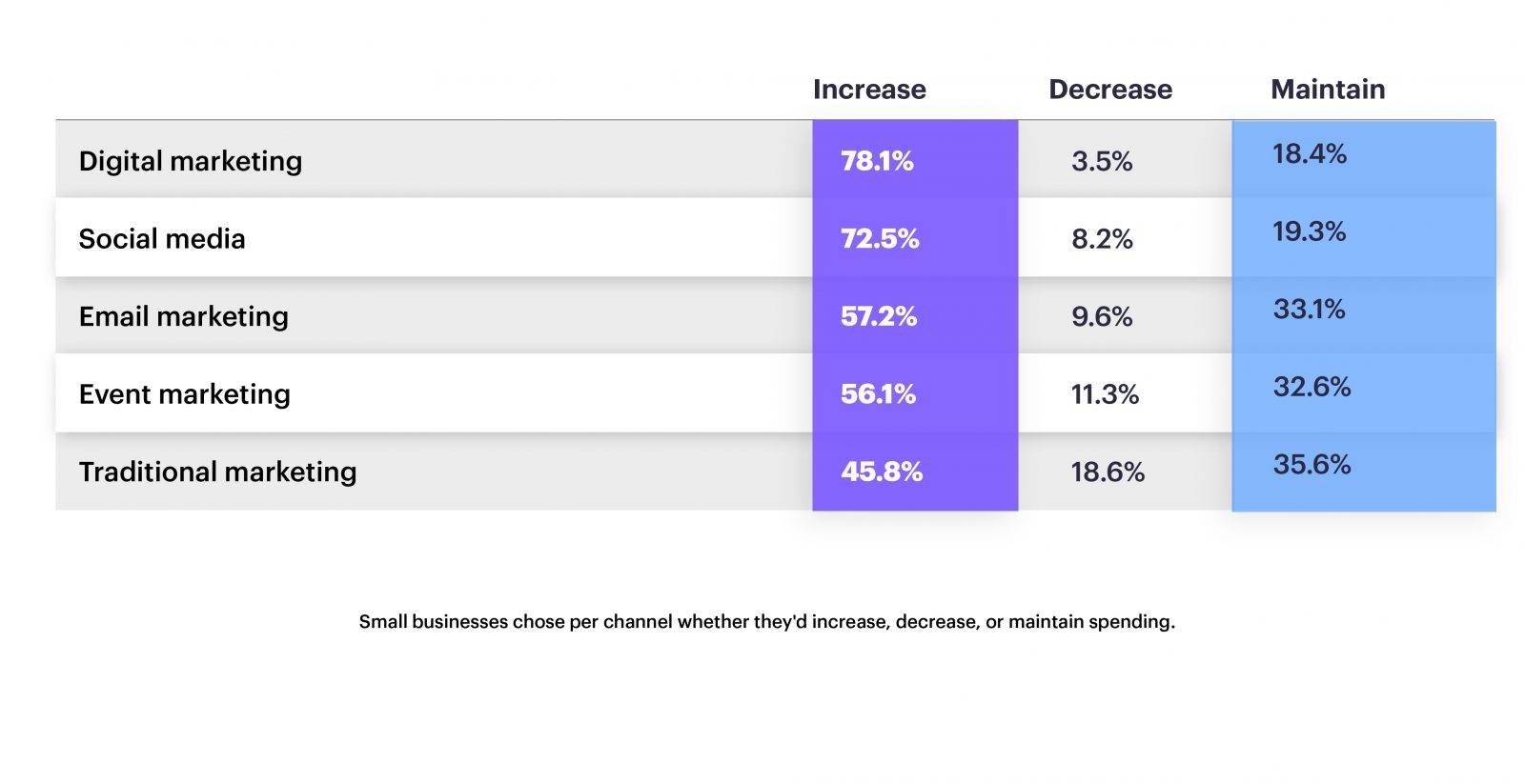
The same companies are spending more on digital tactics, too. At the same time, they know that dropping traditional methods altogether would cut their reach in an instant.
Four Steps to Finding the Right Leads Fast
It works hand in hand with digital channels
Many digital tactics evolved from traditional ones. TV inspired display ads. Direct mail led to email marketing. Cold calling became social selling. It’s all connected, which is why old and new often work well together.
Smart marketing professionals and salespeople already use these links effectively. For example:
Real estate agents add QR codes to yard signs, sending prospects to virtual tours
Software brands print social media handles on business cards to boost post-event engagement and referrals
Brick-and-mortar retailers promote e-commerce offers on in-store signage, driving traffic online
Event marketing teams follow up trade show conversations with email drip campaigns, using contact info they gather in-person
Combining traditional and digital like this creates smoother, more coherent customer journeys. It helps brands meet buyers wherever they are, online or off, reducing friction.
For example, MDL Marinas Group captured 900 email sign-ups in three weeks by adding QR codes to membership brochures. This simple method created a clear feedback loop: print → scan → digital nurture → measurable leads.
The director of sales and marketing, Tim Mayer, explained:
Not every tactic pairs perfectly. For example, a TV ad asking viewers to click a link will fall flat because there’s no way to interact. That’s why matching the channel to the message and goal is key.
Pro tip: Want to explore traditional channels without losing momentum on your digital efforts? Start with a small test campaign. Track the results, refine what works, then scale up with confidence.
6 traditional marketing methods that remain powerful
The following six marketing methods have proven their staying power by adapting to modern customer behaviors and integrating well with digital strategies. Here’s what each offers and how to use it well.
1. Print advertisements and promotional content
Putting your brand directly in customers’ hands, print is still one of the simplest ways to reach a local audience. Print mostly entails newspapers, magazines, flyers and brochures here, although more niche options – i.e., differentiators – include:
Postcards
Door hangers
Coupon books
Community bulletin inserts
While digital ads are easily blocked or scrolled past, print ads and materials demand physical interaction and often stick around for longer. Distribute them in person at events, in-store or through the mail (see the next section for more information).
You can even get creative and weave digital tech directly into print media. Here’s an example of a building solutions firm using video postcards:
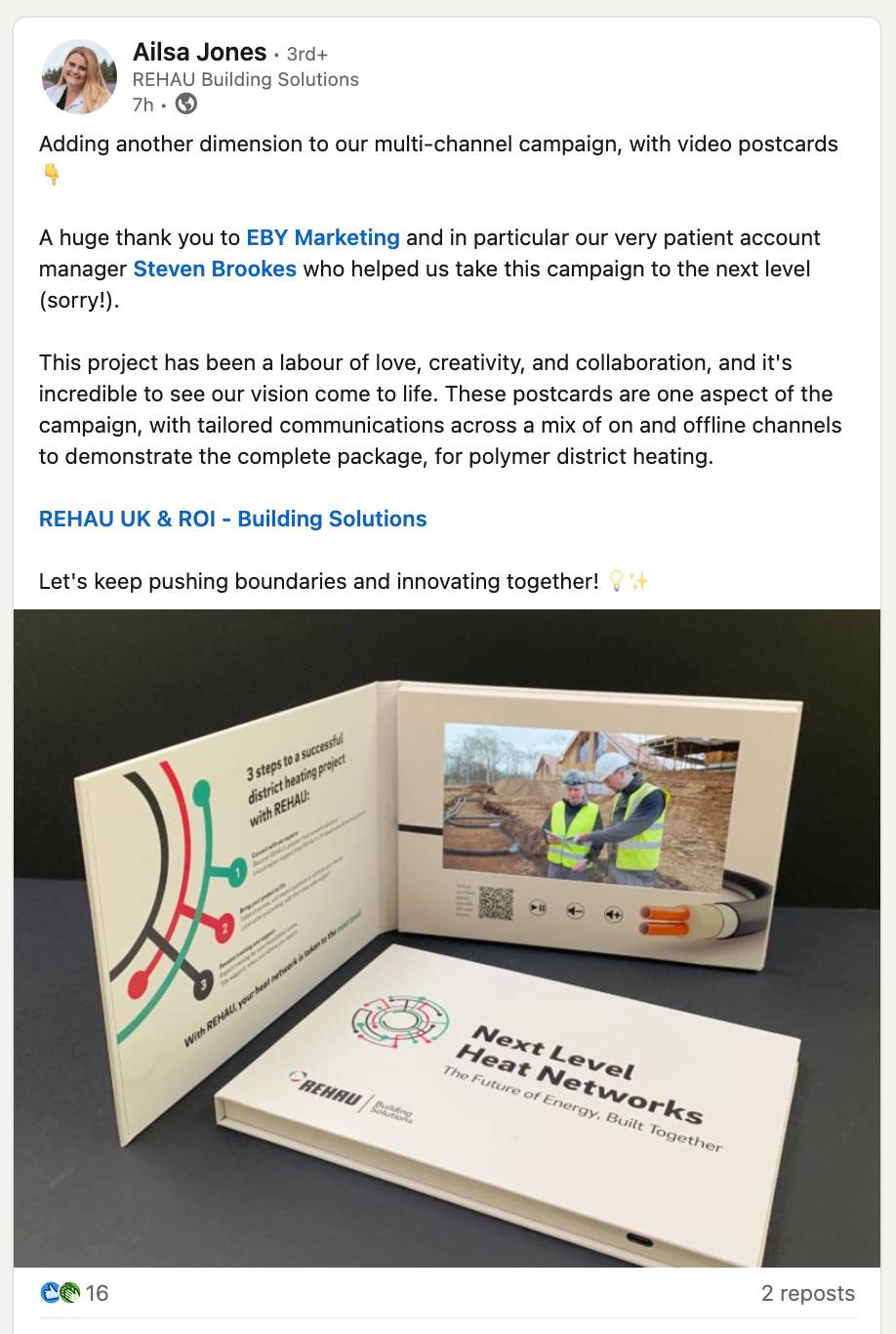
Being more expensive and larger than standard printed materials, these video postcards better suit smaller-scale campaigns and in-person delivery. Still, they’ll certainly help you stand out at a busy trade show.
Top tip: Use a QR code or short URL to link print to digital – they help monitor response rates and show what’s working. Pipedrive’s CRM lets you track where leads came from, even if the journey started with a flyer or brochure. Just tag the source and watch how those contacts move through your pipeline.
2. Direct mail marketing
Direct mail takes targeted messages straight to potential customers’ mailboxes. It can use any of those print materials just discussed, although some formats suit physical delivery more than others.
Postcards are lightweight, making them easy to store and cheap to send en masse. They’re also easily customizable using print companies like Vistaprint, MOO Print and even FedEx.
Brochures cost more to ship due to their size and weight, but are still highly customizable and can carry lots of information. Use them to nurture smaller pools of qualified leads, or even to help individual deals along.
Coupon books can quickly grow foot traffic, especially if you’re new to an area. Bulk-send welcome offers to grow brand awareness and entice new customers, then wow them into returning. Use off-peak discounts as part of flash sales to fill slow periods.
Your Golf Travel sent brochures to “tens of thousands” of golfers to generate interest in its trips and services. This marketing asset straddles traditional and digital, as it’s also available on the Your Golf Travel website.
Users who give their details can read this and various other guides in full, with a convenient live chat link in the bottom left corner to capture leads’ details:
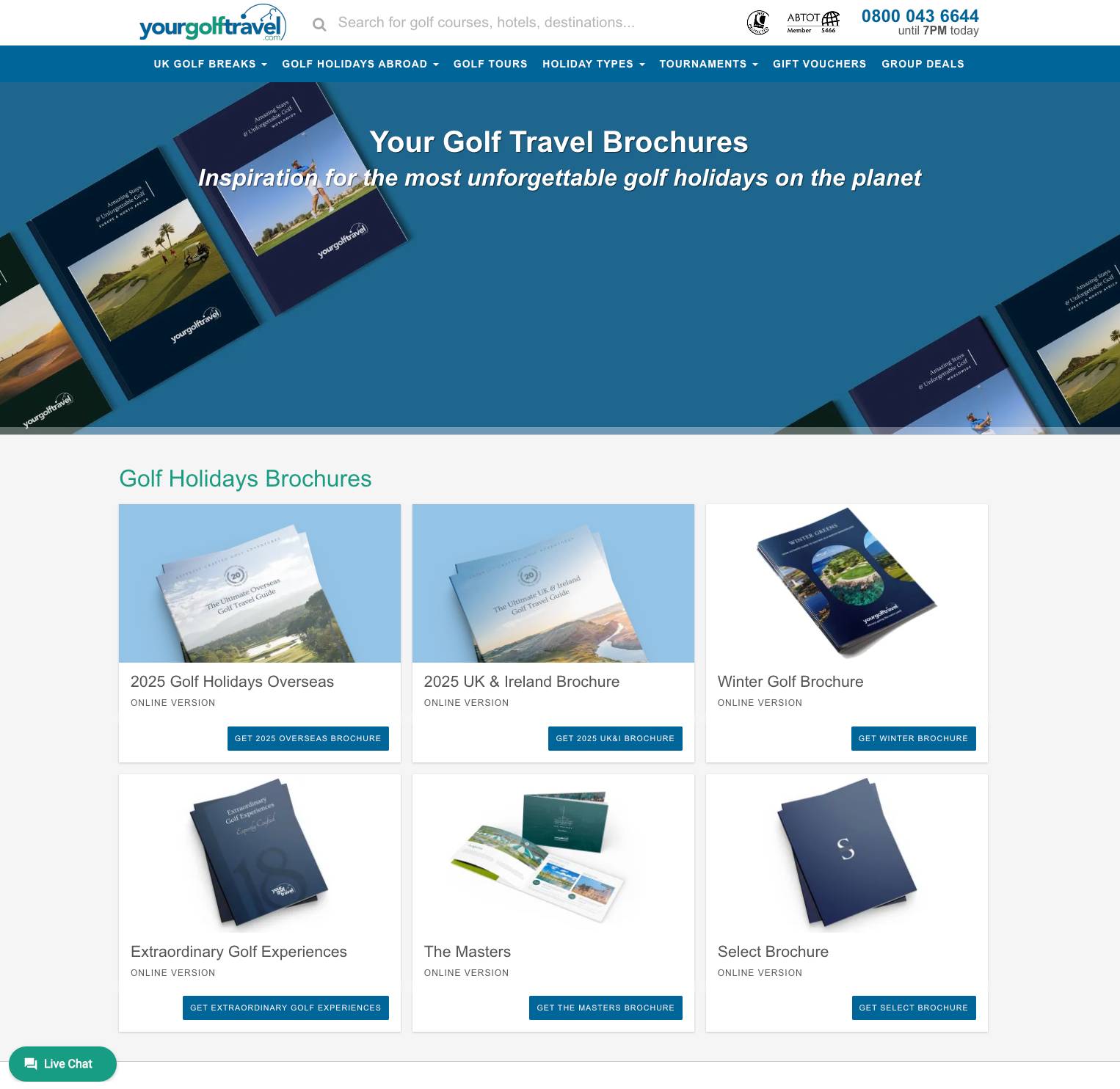
Delivered straight to golfers’ mailboxes, the physical brochures are hard to ignore. The digital versions give more info in a convenient, shareable format, viewable on a range of devices.
Top tip: Pay attention to what comes through your own door, at home or at work, because your audience will likely receive similar marketing material. What stands out? What makes you take mail straight to the trash? Use what you learn to craft something fresh and exciting with a super-clear message.
3. TV and radio advertising
You won’t beat TV and radio ads for reach. A place on the right channel at the right time puts your brand in front of thousands or even millions of prospective customers.
Precise targeting isn’t a strong point here, but you can still choose placement based on the likely audience. Here are a few examples:
Toy brands target families by advertising on kids’ TV
Hardware stores book morning slots on local radio to reach listeners planning their weekends
Retail banks advertise during weekday news bulletins, targeting working professionals who are interested in the economy
Car dealerships choose drive-time slots when commuters are listening
Worried about the cost of TV advertising? One Reddit user from a video production company told this reassuring story:

This case shows that even if you’ve always assumed TV was out of reach, support from the right production company could make it feasible.
Top tip: Keep messages short and consistent. Name your brand more than once to build familiarity without forcing it into every line – you’ll just put the audience off. Finish on a memorable call to action (CTA) that supports your digital marketing efforts, like “find us at [short URL]” or “follow us on [social media profile]”.
4. Billboards and outdoor advertising
Billboards and outdoor signs create unavoidable brand impressions for drivers and pedestrians.
Most companies build awareness with these large-format ads, and it works. However, you can also reinforce the messaging people see elsewhere, like on your website or social profiles.
For example, Canva cleverly uses the limits of outdoor ad space to promote its beginner-friendly design software:
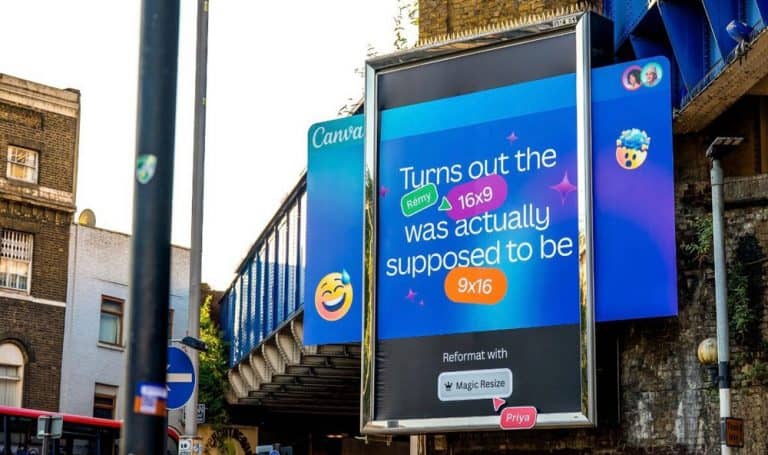
The ad’s unusual layout grabs attention, and its playful messaging shows off a key benefit: helping non-designers get content into the right aspect ratios. It doesn’t give everything away, but just enough to make anyone with design tasks think, “Hey, I have that issue, too”.
Top tip: Be bold and brief. Boldness catches eyes and sharp messaging gets your point across in minimal time. Stick to one simple idea for each outdoor ad, as passers-by will only have seconds to absorb it. The aim is to intrigue rather than force an entire sales pitch into one small space.
5. Face-to-face marketing
Face-to-face marketing generally happens at trade shows, networking events, in-store sales demos and community meet-ups. It can involve one-on-one conversations or speaking to a group.
Marketing to people in person allows them to read your body language and tone in real time, so they can decide whether to trust you much faster.
This immediacy can work for or against you. A great impression builds confidence, while a bad one lingers. That’s why it’s vital to focus on helping, not always selling – just like you would in a well-balanced content marketing strategy.
Let’s say you’re a cybersecurity sales consultant going to this networking event:
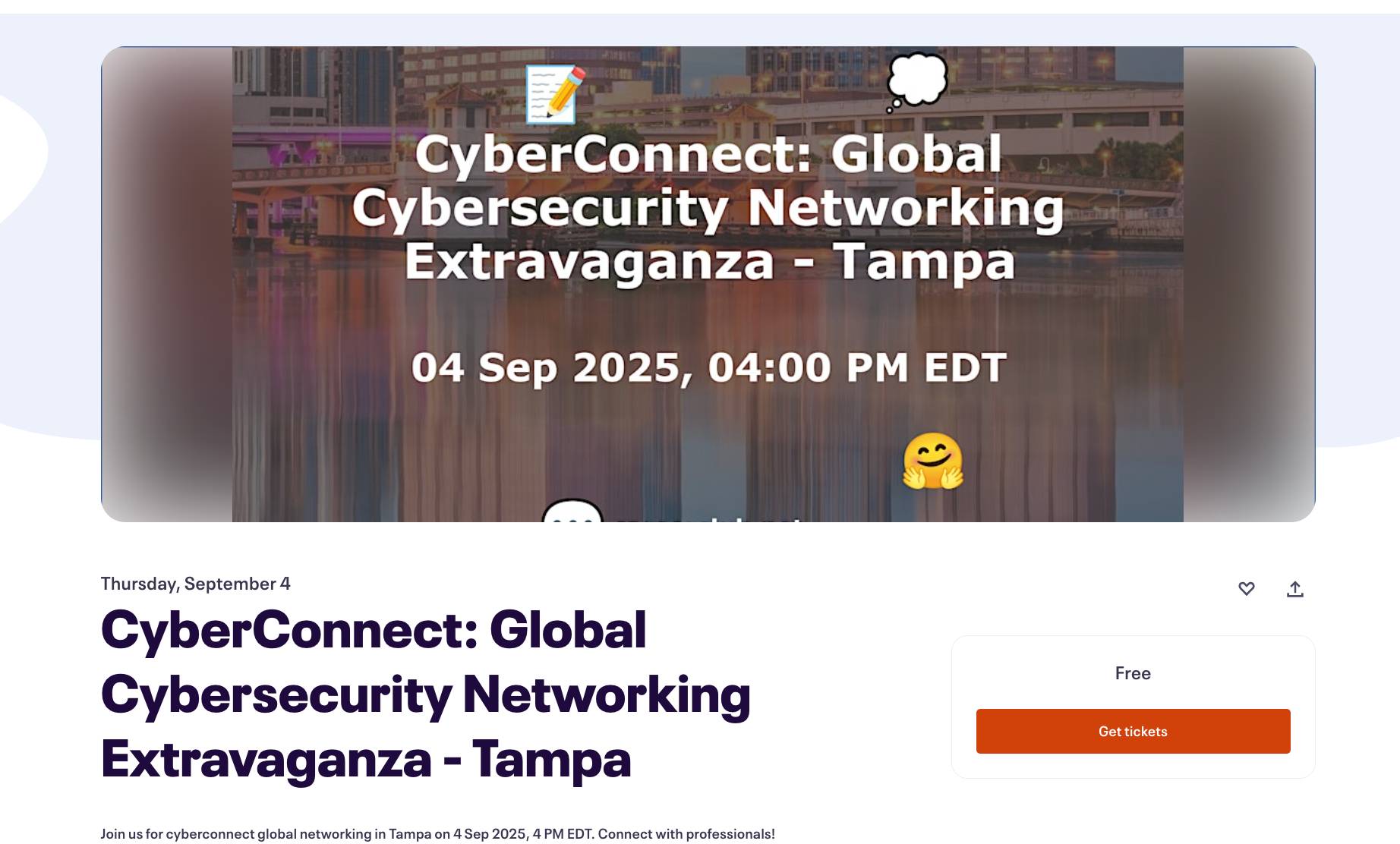
You have two options: pitch your latest package to everyone you meet or drop practical tips into informal chats.
The first option puts people off talking to you because buying isn’t what they came for. The second builds trust without the pressure. It may take weeks to forge a strong connection, though the impact lasts longer.
Top tip: Ask questions, share useful ideas and leave people with something to remember you by. While they may not need your service today, you’ll be front of mind when the right moment comes along. Log those interactions in your customer relationship management system straight after each event, so you can follow up with the right message at the right time.
Do you know one of the best ways to be memorable? Give out thoughtful business cards.
6. Business cards
Business cards still matter for networking because they create lasting connections beyond initial meetings. Well-designed cards with clear contact info make it easy for prospects to remember you and act later.
Below is the card Josie Ryan uses for her business Word Matters. It’s straight to the point, stating who she is, what the brand’s called and what it provides – all in simple dark text on a white background, subtly symbolic of a copywriter’s product.
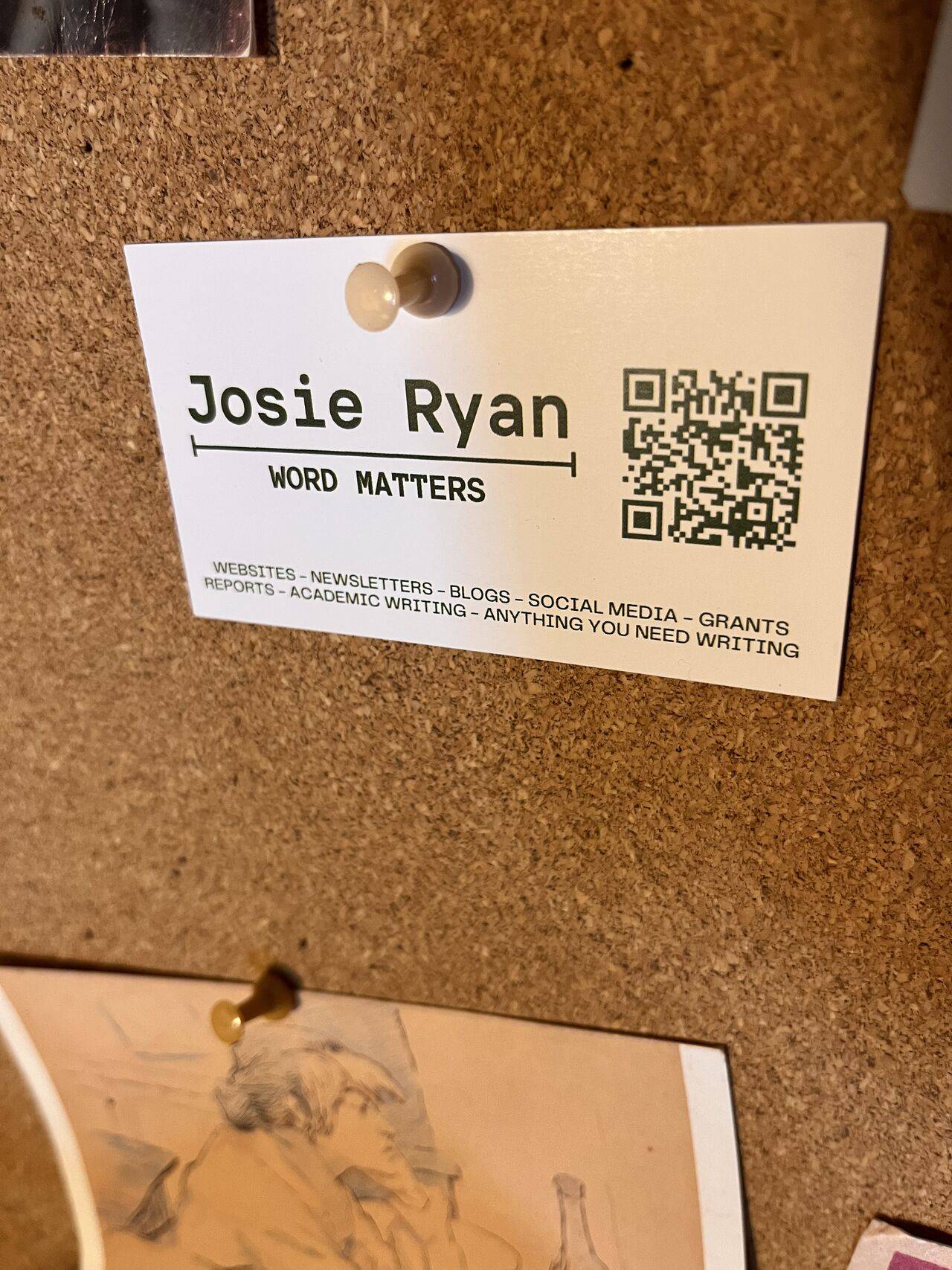
The QR code takes you straight to Josie’s website, which elaborates on all her services. The more this marketing tool is shared, the more traffic it can generate.
Traffic and interactions aren’t the only way to harness QR codes on business cards. Belton Construction is a small business that uses them to generate reviews from its customers:
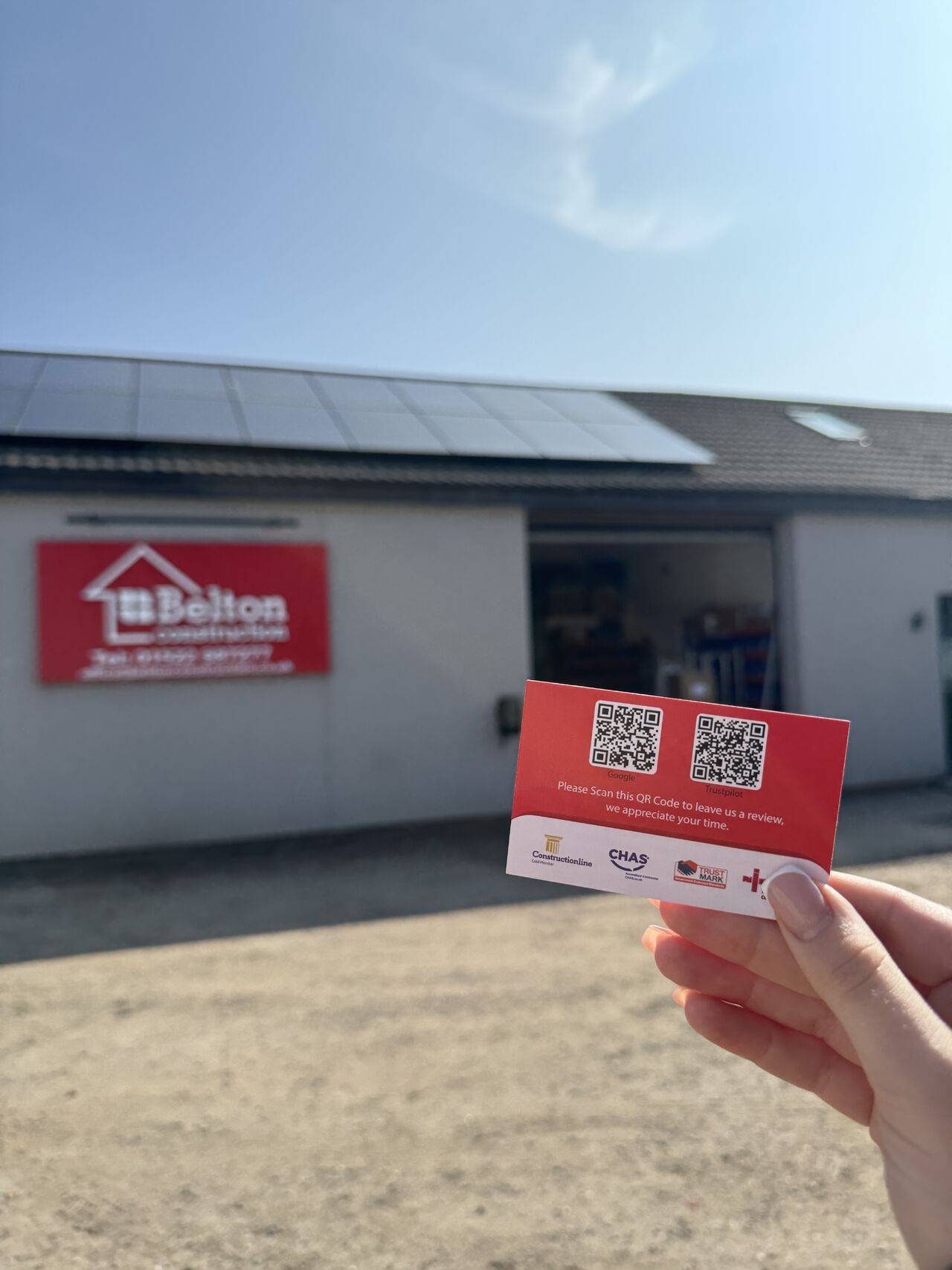
It’s easier than ever to design your own business cards like these. Printing costs are also affordable for most small business owners and freelancers. Canva, Zazzle and Adobe are a few providers with intuitive design tools and integrated printing services.
Top tip: Make your card work harder by adding a QR code that serves a specific purpose. It could be driving website traffic, collecting reviews or booking meetings. Keep the design clean and professional while ensuring that the QR code has enough contrast and size to scan easily. Test it with a smartphone before printing.
4 easy ways to make traditional marketing more measurable
The biggest challenge of traditional advertising and marketing has always been tracking results, although modern tools make measurement much simpler than before.
Here are a few ideas for measuring traditional marketing approaches:
Tracking method | How it works and recommendations |
QR codes and custom URLs | Create unique landing pages for each type of marketing campaign to see which tactics drive the most engagement. For example, use “yoursite.com/radio” for radio ads and “yoursite.com/postcard” for direct mail. Then, track visits, conversions and lead quality by source in a website analytics tool. |
Unique phone numbers | Use different extensions or dedicated lines for radio and TV ads to identify which campaigns generate calls. Call tracking software can assign unique numbers to different campaigns automatically and provide detailed analytics. |
In-person and promotion-specific tracking | Train your team to ask “How did you hear about us?” and log responses in your sales CRM. Use unique discount codes for different materials, like “RADIO15” for radio listeners or “CARD20” for business card recipients. |
CRM integration | Track lead sources from first contact through final sale to see which traditional methods generate the highest-value customers. Modern CRMs make it easy to tag leads by source and follow their complete journey, showing true ROI by channel. |
With the right tools and habits, you can track offline campaigns almost as confidently as digital ones. Just remember that the goal isn’t to get perfect outcomes every time. It’s far more important to get enough data to see what’s working, so you can keep improving the next round.
For example, if Pipedrive’s sales pipeline view (below) shows that leads from a printed brochure tend to drop off after visiting your site or contacting a sales rep, that’s a signal.

Maybe the messaging doesn’t connect. Maybe the follow-up steps aren’t strong enough. Your CRM system helps you spot and fix those gaps before you overspend on the same mistakes.
Other ways you can use a CRM like Pipedrive to strengthen traditional marketing efforts are:
Segmenting customers by source. Group contacts from traditional channels to tailor follow-up emails or calls.
Setting activity reminders. Keeping sales reps in the loop to ensure leads stay warm.
Analyzing conversion rates. See which channels actually deliver qualified leads, and which need dropping or refining.
The more you connect your offline marketing efforts to your online sales software, the easier it is to double down on what gets the best results.
Final thoughts
The key to successfully using traditional and online marketing is to think hybrid, not either-or.
Rely on traditional marketing campaigns to drive awareness and build trust. Then, guide prospects to digital touchpoints where you can nurture the relationships and track engagement.
This best-of-both-worlds approach delivers fantastic ROI by standing out and creating memorable brand experiences that stick with prospects longer.
